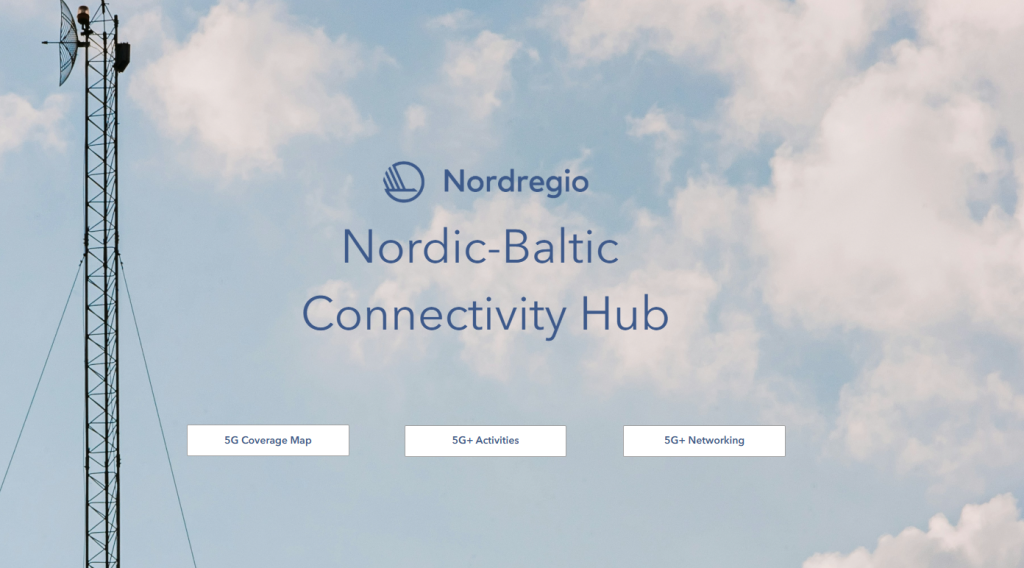How do we ensure that all parts of the Nordic-Baltic region benefit from the rollout of 5G – and that the people driving digital innovation can find each other? A new tool, developed as part of the N-B Connect project, is designed to meet that challenge.

Explore the Nordic-Baltic Connectivity Hub, available here
A living map of connectivity and use cases
“Innovators can use it to find partners and actively publish their own collaboration needs.”
The Nordic-Baltic Connectivity Hub, built on the foundation of an earlier 5G data dashboard and now available in its pilot version, offers an interactive map of 5G coverage across the region along with a networking platform. Hub users can explore use cases, submit collaboration requests, and connect with others working on similar initiatives – a means to drive digital innovation and foster cross-border knowledge exchange.
“We created the Nordic-Baltic Connectivity Hub to ensure that the entire region benefits from the advancements in 5G technology,” says Nicola Wendt-Lucas, project manager and Senior Research Fellow at Nordregio. “It helps policymakers identify areas that need improvement and track progress towards the EU’s 2030 gigabit network goal. At the same time, innovators can use it to find partners and actively publish their own collaboration needs.”
One of the tool’s most innovative aspects is a new feature called 5G+ Networking, which makes it easier for users to actively seek out partnerships.
“It allows users from across the Nordic-Baltic region to submit, explore, and find collaboration requests,” explains Madelene Sonesson, Cartographer and GIS Analyst at Nordregio, who developed the new tool. “This enables them to supply information on ongoing or coming projects that are in need of partnerships.”
Users can also “compare 5G coverage between countries, regions and municipalities by accessing the latest coverage data in the Nordic-Baltic region,” she adds, noting that this data collection is continuous. The countries in this update are Sweden, Finland, Denmark, Norway, Lithuania, and the rest will be updated after summer.
Data is collected at the municipal level and includes the percentage of households with access to 5G at a minimum of 100 Mbps downlink. The data reflects the percentage of households with access to 5G at 100 Mbps or higher. In addition, the tool gathers information on 5G use cases and innovation hubs throughout the region, allowing users to explore how 5G development is progressing through different projects. Sonesson explains that you can “explore the use cases and potential collaboration requests in the region by operating a number of filters, which allow them to easily find projects that meet their criteria or are of interest to them.”
Contributions are open and encouraged. “Stakeholders can contribute to the tool in two ways. Either by submitting information about their use case or by submitting requests for collaboration.”
Early industry interest
“This business is still in the early phase. Sharing experiences and practices is very important and useful.”
The tool is already attracting attention from telecom industry representatives like Mika Skarp, Senior Business Development Manager at Cumucore.
“Private Mobile Networks (PMN) are used by different kinds of organisations. This business is still in the early phase and sharing experiences and practices is very important and useful. It helps a lot of organisations that are interested to start experimenting with PMNs if they can browse through projects that have been implemented,” says Skarp.
Cumucore, based in Espoo, Finland, specialises in private 4G, 5G, and 6G networks for Industry 4.0 and media applications. The company is currently managing a university network in Finland used for advanced testing.
“For us this kind of tool is to get to know projects that have been done. In the future, this kind of tool could be used to coordinate networks’ RF parameters, and it could be a place to request frequency licenses,” Skarp adds.
Project manager Nicola Wendt-Lucas also sees a clear future direction and regional value:
“We hope that the Nordic-Baltic Connectivity Hub will enable smart communities to identify collaboration opportunities based on their technical needs, and to solidify the region’s leadership in digital innovation.”
Start exploring the tool here:
For more insight into the N-B Connect project and our ongoing research across digital inclusion and smart communities, check out the Nordic-Baltic DigiHub for a collection of key resources.




